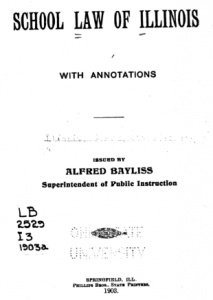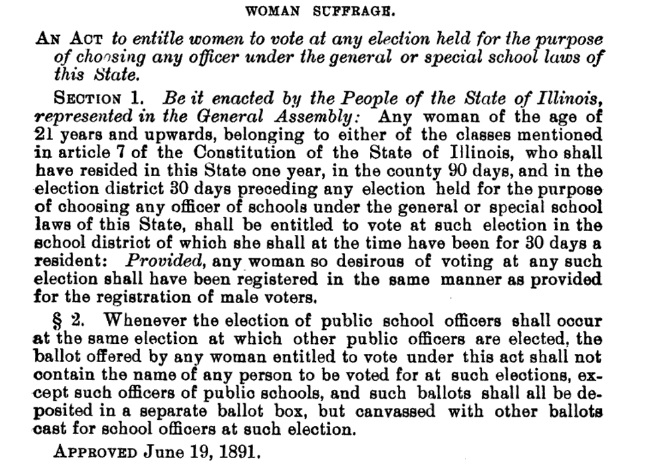 On 19 June 1891, the Illinois General Assembly gave women in Illinois the right to vote–in school elections.
On 19 June 1891, the Illinois General Assembly gave women in Illinois the right to vote–in school elections.
The 1891 act was specific in stating that women could only vote in school elections. But it was a start and does mean that women could vote in at least some elections in Illinois before the 19th amendment was passed to the United States Constitution.
I’m not certain if any of my female ancestors living in Illinois would have been interested enough in school elections to actually vote. I am curious as to what the local reaction to women’s suffrage was in Adams and Hancock Counties where my families were living at the time this law was passed.
Which of my 1891 female ancestors living in Illinois would have been eligible to vote? For native-born citizens who married native-born citizens, the answer is easy. The problem occasionally comes into play with individuals born outside the United States are involved. There are several categories (the list is not meant to be exhaustive), some of which I have people in:
- native born and married to a native born citizen–Nancy Jane (Newman) Rampley, born in 1846 in Rush County, Indiana, married to Ohio native Riley Rampley and living in Hancock County, Illinois in 1891. Eligible.
- native born and married to a naturalized immigrant–Anna (Dirks) Goldenstein, born in 1861 in Adams County, Illinois, married to naturalized German native Focke Goldenstein and living in Hancock County, Illinois, in 1891.
- foreign born and married to a naturalized immigrant–Noentje Lena (Grass) Ufkes, born 1848 in Backemoor, Ostfriesland, Germany, married to naturalized German native Johann Ufkes and living in Hancock County, Illinois, in 1891.
- foreign born and married to a native born citizen–I don’t have any of those.
- native born and married to an un-naturalized immigrant–I don’t have any of those either
- [this was a repeat–thanks to a reader for catching that]
An interesting “side project” would be to try and determine which of my female ancestors would have been eligible to vote under the 1891 act. The Act indicated that women who would be eligible to vote under the Illinois Constitution in effect in 1891 would have been able to vote.
And there’s the answer. Maybe.
Women’s citizenship was still tied to that of their father or husband in 1891. That muddied the waters as we will see in a future post.
And…the “being entitled to vote if the constitution in effect at the time allowed them to vote?” That caused problems also–as we’ll see in another future post.

“School Law of Illinois: With Annotations,” Alfred Bayliss, Superintendent of Public Instruction, 1903, Springfield, Illinois, page 165.

3 Responses
Just a heads up: you have “native born and married to a naturalized immigrant” listed twice in your bullet points. #2 and #6. Looking at your other bullets, I’m guessing perhaps you meant to put “foreign born and married to an un-naturalized immigrant.” 🙂
Interesting info to consider though. I’ll have to look further into my Deep South roots and see what hidden pieces of information I can glean.
Thanks for catching that and letting me know–I’ve made the change.
I’m wondering whether or not all my immigrants were considered eligible to vote and I’m curious if my US natives who married US natives voted. I had not really considered any women voting before the 19th amendment.
This very interesting. After a little searching, I couldn’t find any voter registrations in the FamilySearch catalog for counties of interest. The Illinois State Archives didn’t seem to have any either. Might have to try local historical societies to see if any remain.